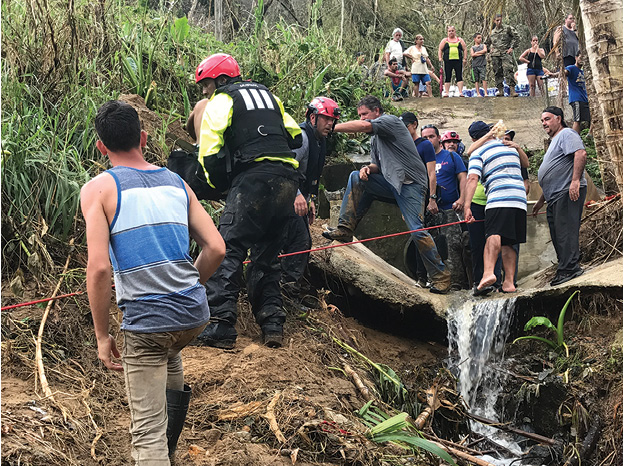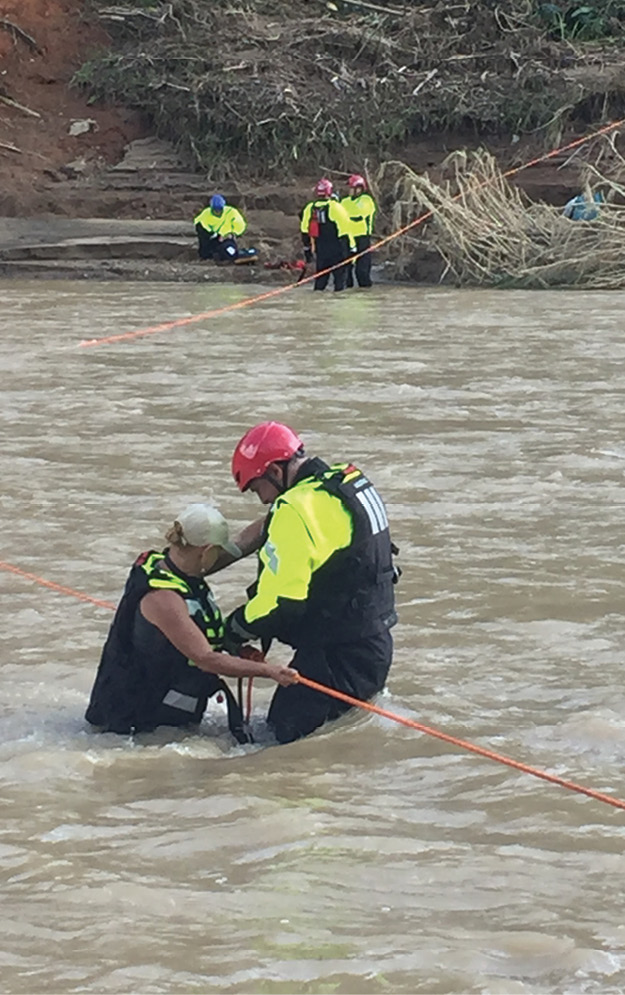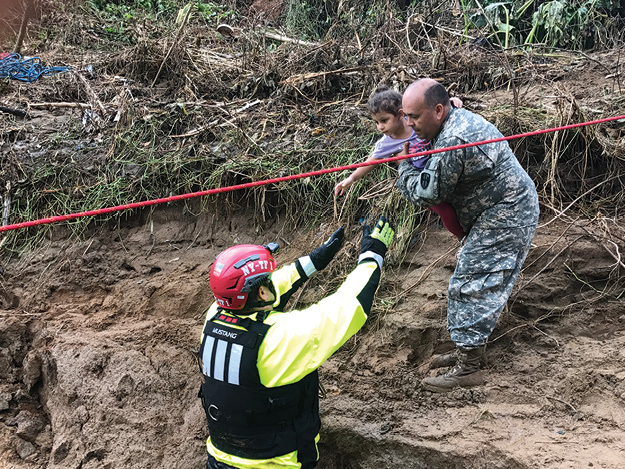
By Jack Flatley
With Hurricane Harvey approaching the continental United States, the Federal Emergency Management Agency (FEMA) predeployed six urban search and rescue (US&R) teams to Texas. Harvey immediately impacted Houston and the surrounding areas with heavy rains and flooding. FEMA then activated the remaining teams to assist. Some teams were deployed as a National Incident Management System (NIMS) Type III or a Mission Ready Package (MRP); others were deployed as Type I teams with 80 members. New York Task Force 11 (NY-TF1) was deployed as a Type 1 (photo 2).

(1) Villagers collect on bridge remnants to receive needed supplies in Utuado, Puerto Rico. (Photo by Andrea Booher/FEMA.)
NY-TF1 received its activation order on August 26 at 9 p.m. and began to mobilize its members. The team members assembled at their warehouse in Brooklyn, New York, under the direction of Task Force Leader (TFL) Mike McGuinness, of the New York Police Department, and my direction, as deputy TFL. Members checked in, were medically evaluated by the team doctor, and were given their equipment for deployment. The logistics section readied the fleet of 18 vehicles and trailers for a 3 a.m. departure. On August 27, we began our 36-hour response to Texas. The convoy encountered a few minor vehicular issues along the 1,400-mile response route; they were corrected along the way. The team arrived in the Houston area while it was still raining. NY-TF1’s original destination was the AT&T Center in Arlington, Texas. En route, the team was redirected to Katy, Texas; its final destination was to be the Angelton Emergency Operation Center in Brazoria County, Texas.
Brazoria County
There, NY-TF1 met its 1st Branch Director Todd Magliocca. The officials of Brazoria County, the authority having jurisdiction (AHJ), planned the operations and sectors in which the team would operate. There were to be no night operations; to cover more ground, NY-TF1 was divided into two squads, the Red team and the Blue team, which would operate in 12-hour shifts. Each squad was equipped with a water operations trailer, which contained four boats (two inflatable and two flat bottoms); motors; safety equipment; and supplies.
The county was divided into five sectors. The Red team operated in sector 2, and the Blue team operated in sector 5. The Blue team made a dramatic rescue of a farmer in a tractor stuck in swift moving water in sector 5 (photo 3). While conducting damage and needs assessments in the town of Sweeney, the Blue Team became aware of an individual who had driven a tractor into moving water; the tractor was stuck. The team used a high-axle vehicle to drive into the area where the incident had been reported and found the area completely inundated with standing water. After driving for several minutes, the team observed a tractor that had become rendered inoperable as it traveled through a portion of the road that had been washed out by swift moving water. The operator had driven the two passenger side wheels off the road, resulting in the tractor listing to the side and in danger of turning over. Wearing the appropriate personal protective equipment and using accepted swift water rescue boat practices, the team launched an inflatable boat with a three-person boat crew and made its way approximately 75 feet through the swift water to access the cab of the tractor. Once they bowed up to the cab of the tractor, the operator was placed in a personal flotation device and removed from the cab to the safety of the inflatable boat. The boat crew then made their way out of the moving water back to the awaiting high-axle vehicle.
Other teams operating in Brazoria County were Florida-TF1, Pennsylvania-TF1, Maryland-TF1, and California-TF5. All teams were eventually relieved by Texas-TF1. As rescue operations transitioned to recovery efforts, the teams from Angelton were relocated to the demobilization center in Katy, where the team trucks, vehicles, and equipment were serviced and decontaminated. Some TF teams were demobilized; others were held in reserve. This action allowed teams to move eastward in anticipation of deployment to Hurricane Irma, which was spinning up through the Caribbean, devastating the U.S. Virgin Islands. It was predicted to make landfall on the mainland United States.
Redeployment to Hurricane Irma
NY-TF1 made stops in Louisiana and Alabama before finally receiving orders from the National Blue Incident Support Team (IST) to report to Robbins Air Force Base in Georgia. The group of teams from Angelton—except for the Florida team, which was returned to Florida as a vital state asset—was redirected there for potential Hurricane Irma deployment.
In anticipation of an extended deployment, all 80 members of NY-TF1 were replaced; New York City Emergency Management handled the logistics for this task. The new team flew to Atlanta on commercial airlines. As the members deployed for Hurricane Harvey returned to New York City, the fresh members readied themselves and the team’s equipment for the new Irma deployment.

(2-4) Photos courtesy of New York Task Force 1.
In keeping with the NY-TF1 tradition of alternating the leader and deputy leader positions between the FDNY and the NYPD on each deployment, NY-TF1 was now under the direction of TFL James Yakimovich (FDNY) and Deputy TFL Steve Finnegan (NYPD). The Irma NY-TF1 readied for a deployment to Puerto Rico. Subsequently, the Blue IST activated NY-TF1 and flew the members to Puerto Rico.
NY-TF1 flew to Puerto Rico and staged there, but Irma only skirted the island and caused limited damage. NY-TF1 was demobilized on September 13 and returned to New York on September 18.
Hurricane Maria, Puerto Rico
Ironically, as history will tell, there would be no rest for the weary. September 18 found Hurricane Maria strengthening in the Caribbean Sea and set to make landfall on Puerto Rico head-on as a category 5 hurricane. FEMA activated NY-TF1 on September 20 for a Type IV team response, requesting that 27 members of the NY-TF1 fly back to Puerto Rico. NY-TF1 drove to Stewart Air Force Base in Newburgh, New York, and awaited aircraft assignment. On September 22, the team, under the direction of TFL Michael McGuinness (NYPD), departed for Puerto Rico, picking up Massachusetts TF1 (MA-TF1) along the way.
NY-TF1 arrived in Puerto Rico at 1820 hours on September 23. The intelligence provided was that Puerto Rico was divided into three regions: East, West, and Central. NY-TF1 and MA-TF1 were assigned to the Central region to conduct reconnaissance. MA-TF1 would perform that recon from the ground; NY-TF1 was assigned to recon by helicopter. The Central region was subdivided into three geographical areas of major concern since there were no communications from which to gauge the storm damage.
Early the next morning (September 24), NY-TF1 began to survey the three areas; all were believed to be inaccessible by vehicle. Both TFs met with local officials to establish the needs of their respective communities. Those needs were identified, prioritized, and taken back to the FEMA IST in San Juan. It was determined that the town of Utuado in the Central mountain region was the area in greatest need of assistance.

Utuado: Only Bridge Washed Out
On September 26, the entire NY-TF1 went to Utuado, where a bridge off Route 123 had washed out. The bridge was the main access/egress route off that side of the mountain over the Rio Grande de Arecibo (Vivi River). It now would take more than two hours to get to the next town on the other side of the mountain. NY-TF1 members, wearing swift-water suits, rigged up a guideline system across the river with anchor points on either side. The guideline was used for an inflatable boat to bring members, food, and water across the river. The boat was hauled back and forth across the river using a pulley system. Food and water were ferried across that system throughout the day. Residents on the other side of the river helped bring the food up the riverbank. The food and water was then brought to a local church where supplies were distributed evenly to all 125 households in need. Additional food and water were supplied later in the week using the same boat operation system.
On the second trip, the NY-TF1 team physician documented a list of prescription medications required by the residents; the order was filled and delivered on Monday, October 2. Each of these missions was carried out using the same pulley and boat system.
Other Communities
During the deployment to Puerto Rico, NY-TF1 members performed many functions including restoring generators to hospitals and nursing homes. Because of the lack of cell phone service, several wellness checks were done in all three regions of the island. NY-TF1 met with local officials in many communities to gather information on what supplies and resources were needed. Besides food and water, many municipalities required diesel fuel for generators and ambulances, medical supplies, and refills of prescription medications.
NY-TF1 team members returned to New York on October 5. The cache of equipment was shipped by ocean barge, arranged through FEMA, and returned to NYC on November 1.

NY-TF1 also subsequently deployed the IST leader, communication specialists, and logistics specialists to the Red and Blue FEMA ISTs assigned in the other two regions of the island, some for as long as 28 days (photo 4). The 2017 hurricane season proved to be challenging for all levels of government. The logistics of moving 28 US&R teams around the country and beyond over a six-week period was unprecedented.
Note: The author thanks the following for their contributions to this article: Battalion Chief Joseph Downey, a 32-year veteran of the Fire Department of New York assigned to the FDNY Rescue Operations Command and a leader of NY-TF1; Lieutenant Michael McGuinness, a 25-year veteran of the New York Police Department assigned to the Emergency Services Unit and a leader of NY-TF1; and Captain Dominic Bertucci, a 22-veteran of the FDNY Rescue Operations Command, assigned to the Planning section of NY-TF1.
Endnote
1. New York Task Force 1 (NY-TF1), one of the 28 federal urban search and rescue teams administered by the Federal Emergency Management Agency, Department of Homeland Security, is sponsored by the New York City Emergency Management (NYCEM) and includes members of the Fire Department of New York and the New York Police Department. The team members are certified and capable of operating in all-hazard environments to locate and rescue trapped individuals and provide medical care. Their training prepares them to operate at structural collapses, confined spaces, trench collapses, hazardous materials incidents, wide-area searches, and water emergencies. NY-TF1 has a transportation fleet that moves 16,400 pieces of equipment in their cache. The equipment cache allows NY-TF1 to be self-sufficient for 72 hours at any incident. NY-TF1 has responded to many disasters, including terrorist attacks, the Oklahoma City bombing, earthquakes in Haiti, numerous hurricanes, severe ice storms and snowstorms, and floods.
Jack Flatley is a 27-year veteran of and a battalion chief with the Fire Department of New York (FDNY) assigned to Division 13. He has served 20 years with FDNY Special Operations Command and is a task force leader for NY-TF1. His previous assignments included Squad 1, Squad 41, and Rescue Co. 1.

